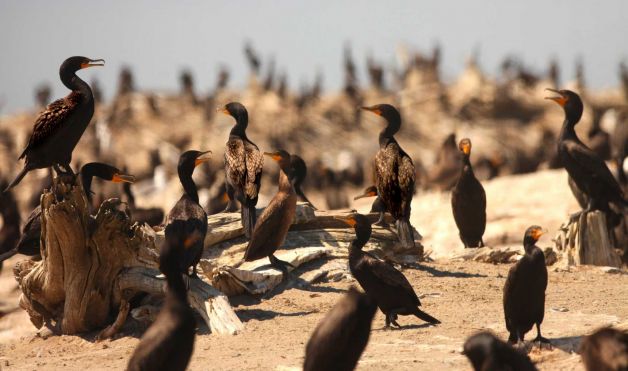forum
library
tutorial
contact

Judge Refuses to Halt Lethal
Removal of Cormorants
by Bill Rudolph
NW Fishletter, May 23, 2015
|
the film forum library tutorial contact |

|
Judge Refuses to Halt Lethal
by Bill Rudolph
|
 Oregon federal judge Michael Simon ruled May 8 against bird lovers--Audubon Society of Portland et al. v. U.S. Army Corps of Engineers et al.--trying to stop a Corps of Engineers' plan that calls for shooting up to 3,500 double-crested cormorants in the lower Columbia River each year for the next four years. The drastic strategy is part of a management plan to reduce avian predation on ESA-listed juvenile salmonids that is one of the 73 actions called for in the 2014 hydro BiOp.
Oregon federal judge Michael Simon ruled May 8 against bird lovers--Audubon Society of Portland et al. v. U.S. Army Corps of Engineers et al.--trying to stop a Corps of Engineers' plan that calls for shooting up to 3,500 double-crested cormorants in the lower Columbia River each year for the next four years. The drastic strategy is part of a management plan to reduce avian predation on ESA-listed juvenile salmonids that is one of the 73 actions called for in the 2014 hydro BiOp.
Judge Simon said plaintiffs failed to produce evidence that lethally removing that number of cormorants in 2015 would cause the likelihood of "irrevocable harm" to the overall population at the species or colony level.
Attorney Dan Rohlf, representing the Audubon Society, argued that it was likely more cormorants would die from the action that the Corps has estimated, due to the subsequent stress and harassment at the colony on East Sand Island during the culling process. In fact, he argued that it could lead to colony collapse.
Rohlf also cited a recent study that suggested the cormorants would have less impact on juvenile salmonids during low-flow years because more marine forage species could be found at the mouth of the river than in years with more flow and less salt water intrusion.
He argued that any juvenile fish losses could be made up for by spilling more water at federal dams on the Columbia and Snake rivers, citing a memo he had sent to the Court that very morning from the Nez Perce Tribe and U.S. Fish and Wildlife Service that said increased spill would increase smolt-to-adult return rates. The spill regime outlined in the memo was heavily criticized by both NOAA scientists and an independent review panel last year after Oregon recommended it be added to the region's F&W program.
Federal attorneys pointed out that the spill memo was not an official position from USFWS, but just produced by some of its scientists. Further, they argued it was outside the administrative record, for purposes of argument over the motion.
They also explained the concept of "compensatory mortality," which suggests that any fish saved by reducing avian predation would likely suffer mortality from other causes, anyway. The feds said the plaintiffs offered no evidence that compensatory mortality has changed over time, while the size of the cormorant colony has undisputedly increased in size. In fact, they suggested that by the time smolts reach the estuary, they are getting healthier, and any compensatory mortality would likely fall, not rise.
They argued that the federal statute, the Water Resources Development Act, gives the Corps wide authority to deter the cormorant population. They said 26,000 cormorants expected this year will consume 16 million to 20 million juvenile salmonids, including about 2 million or more listed under the ESA.
They said the action is part of many elements in the hydro BiOp to improve salmon survival "holistically," and an injunction that prevents this action from being carried out would frustrate the purpose of full BiOp implementation.
The feds also argued that the West Coast cormorant abundance numbers (around 41,000) cited by plaintiffs, as necessary to maintain a sustainable population, was developed in 1990 and was not a "minimum" sustainable population, which in fact, is much lower.
Federal attorney Bradley Oliphant said nothing presented by the plaintiffs shows any real threat of irrevocable harm to the "species" from the first-year implementation of the Corps' plan.
Judge Simon ultimately agreed with the defendants. But while refusing to grant the motion for temporary injunction, he said he would not comment on the merits of the case at this time. He called on both sides to meet over the next two weeks to agree on a schedule for trial. Hopefully, the case will be settled before the 2016 salmon migration season. The feds said they could likely have the administrative record filed within 90 days.
"We are very disappointed in the court's decision," said Audubon Society of Portland Conservation Director Bob Sallinger, in a May 11 statement. "For the 3,489 cormorants that are scheduled to be shot and 9,368 active nests the Corps plans to oil, destroy or starve, the losses will absolutely be irreversible."
Other plaintiffs in the litigation are the Animal Legal Defense Fund, Center for Biological Diversity, Friends of Animals, and Wildlife Center of the North Coast.
Corps of Engineers' spokesperson Diana Fredlund said personnel from Wildlife Services, a program that is part of the United States Department of Agriculture's Animal and Plant Health Inspection Service, will conduct the lethal removal, which is expected to start soon.
learn more on topics covered in the film
see the video
read the script
learn the songs
discussion forum
